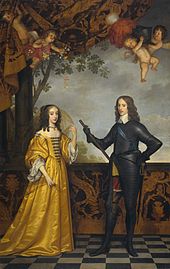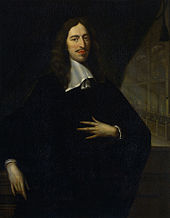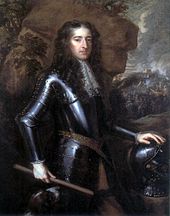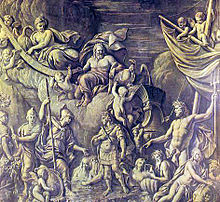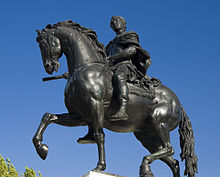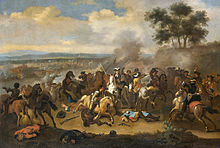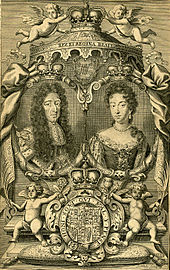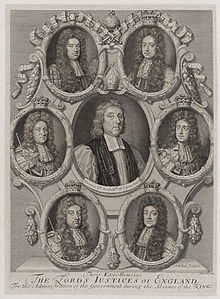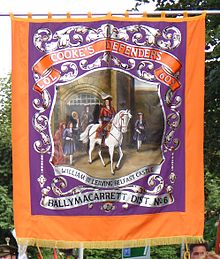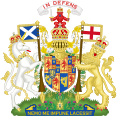
William III of England
Background Information
SOS Children, which runs nearly 200 sos schools in the developing world, organised this selection. SOS Children works in 45 African countries; can you help a child in Africa?
| William III & II | |
|---|---|
 |
|
| William III by Sir Godfrey Kneller | |
|
|
|
| Reign | 4 November 1650 – 8 March 1702 |
| Predecessor | William II |
| Successor | John William Friso |
|
|
|
| Reign | July 1672 – 8 March 1702 |
| Predecessor | William II |
| Successor | William IV |
|
|
|
| Reign | 13 February 1689 – 8 March 1702 |
| Coronation | 11 April 1689 |
| Predecessor | James II & VII |
| Successor | Anne |
| Co-monarch | Mary II |
| Spouse | Mary II of England |
| House | House of Orange-Nassau |
| Father | William II, Prince of Orange |
| Mother | Mary, Princess Royal |
| Born | 4 November 1650 [ N.S.: 14 November 1650] Binnenhof, The Hague |
| Died | 8 March 1702 (aged 51) [ N.S.: 19 March 1702] Kensington Palace, London |
| Burial | Westminster Abbey, London |
| Signature |  |
William III & II (Dutch: Willem III; 4 November 1650 – 8 March 1702) was a sovereign Prince of Orange of the House of Orange-Nassau by birth. From 1672 he governed as Stadtholder William III of Orange (Dutch: Willem III van Oranje) over Holland, Zeeland, Utrecht, Gelderland, and Overijssel of the Dutch Republic. From 1689 he reigned as William III over England and Ireland; it is a coincidence that his regnal number (III) was the same for both Orange and England. As King of Scotland, he is known as William II. He is informally known by sections of the population in Northern Ireland and Scotland as "King Billy". In what became known as the "Glorious Revolution", on 5 November 1688 William invaded England in an action that ultimately deposed King James II & VII and won him the crowns of England, Scotland and Ireland. In the British Isles, William ruled jointly with his wife, Mary II, until her death on 28 December 1694. The period of their joint reign is often referred to as "William and Mary".
A Protestant, William participated in several wars against the powerful Catholic king of France, Louis XIV, in coalition with Protestant and Catholic powers in Europe. Many Protestants heralded him as a champion of their faith. Largely because of that reputation, William was able to take the British crowns when many were fearful of a revival of Catholicism under James. William's victory over James at the Battle of the Boyne in 1690 is still commemorated by the Orange Order. His reign marked the beginning of the transition from the personal rule of the Stuarts to the more Parliament-centred rule of the House of Hanover.
Early life
Birth and family
William Henry of Orange was born in The Hague in the Dutch Republic on 4 November 1650. He was the only child of stadtholder William II, Prince of Orange, and Mary, Princess Royal. Mary was the eldest daughter of King Charles I of England, Scotland and Ireland, and sister of King Charles II and King James II & VII.
Eight days before William's birth, his father died from smallpox; thus William was the Sovereign Prince of Orange from the moment of his birth. Immediately, a conflict ensued between the Princess Royal and William II's mother, Amalia of Solms-Braunfels, over the name to be given to the infant. Mary wanted to name him Charles after her brother, but her mother-in-law insisted on giving him the name William or Willem to bolster his prospects of becoming stadtholder. William II had appointed his wife as his son's guardian in his will; however the document remained unsigned at William II's death and was void. On 13 August 1651 the Hoge Raad van Holland en Zeeland (Supreme Court) ruled that guardianship would be shared between his mother, his paternal grandmother and Frederick William, the Elector of Brandenburg, whose wife, Louise Henriette, was his father's eldest sister.
Childhood and education
William's mother showed little personal interest in her son, sometimes being absent for years, and had always deliberately kept herself apart from Dutch society. William's education was first laid in the hands of several Dutch governesses, and some of English descent, including Walburg Howard. From April 1656, the prince received daily instruction in the Reformed religion from the Calvinist preacher Cornelis Trigland, a follower of the Contra-Remonstrant theologian Gisbertus Voetius. The ideal education for William was described in Discours sur la nourriture de S. H. Monseigneur le Prince d'Orange, a short treatise, perhaps by one of William's tutors, Constantijn Huygens. In these lessons, the prince was taught that he was predestined to become an instrument of Divine Providence, fulfilling the historical destiny of the House of Orange.
From early 1659, William spent seven years at the University of Leiden for a formal education, under the guidance of ethics professor Hendrik Bornius (though never officially enrolling as a student). While residing in the Prinsenhof at Delft, William had a small personal retinue including Hans Willem Bentinck, and a new governor: Frederick Nassau de Zuylenstein, the illegitimate son of stadtholder Frederick Henry of Orange. He was taught French by Samuel Chappuzeau (who was dismissed by William's grandmother after the death of his mother).
Grand Pensionary Johan de Witt and his uncle Cornelis de Graeff pushed the States of Holland to take charge of William's education. This was to ensure he would acquire the skills to serve in a future—though undetermined—state function; the States acted on 25 September 1660. This first involvement of the authorities did not last long. On 23 December 1660, when William was ten years old, his mother died of smallpox at Whitehall Palace, London while visiting her brother King Charles II. In her will, Mary requested that Charles look after William's interests, and Charles now demanded the States of Holland end their interference. To appease Charles, they complied on 30 September 1661. In 1661, Zuylenstein began to work for Charles. He induced William to write letters to Charles asking him to help William become stadtholder someday. After his mother's death, William's education and guardianship became a point of contention between his dynasty's supporters and the advocates of a more republican Netherlands.
The Dutch authorities did their best at first to ignore these intrigues, but in the Second Anglo-Dutch War one of Charles's peace conditions was the improvement of the position of his nephew. As a countermeasure in 1666, when William was sixteen, the States of Holland officially made him a ward of the government, or a "Child of State". All pro-English courtiers, including Zuylenstein, were removed from William's company. William begged De Witt to allow Zuylenstein to stay, but he refused. De Witt, the leading politician of the Republic, took William's education into his own hands, instructing him weekly in state matters—and joining him in a regular game of real tennis.
Early offices
Exclusion from stadtholdership
At William's father's death, the provinces had suspended the office of stadtholder. The Treaty of Westminster, which ended the First Anglo-Dutch War, had a secret annexe attached on demand of Oliver Cromwell: the Act of Seclusion, which forbade the province of Holland to appoint a member of the House of Orange as stadtholder. After the English Restoration, the Act of Seclusion, which had not remained a secret for very long, was declared void as the English Commonwealth (with which the treaty had been concluded) no longer existed. In 1660, Mary and Amalia tried to persuade several provincial States to designate William as their future stadtholder, but they all initially refused.
In 1667, as William III approached the age of eighteen, the Orangist party again attempted to bring him to power by securing for him the offices of stadtholder and Captain-General. To prevent the restoration of the influence of the House of Orange, De Witt allowed the pensionary of Haarlem, Gaspar Fagel, to induce the States of Holland to issue the Perpetual Edict (1667). The Edict declared that the Captain-General or Admiral-General of the Netherlands could not serve as stadtholder in any province. Even so, William's supporters sought ways to enhance his prestige, and on 19 September 1668, the States of Zeeland received him as First Noble. To receive this honour, William had to escape the attention of his state tutors and travel secretly to Middelburg. A month later, Amalia allowed William to manage his own household and declared him to be of majority age.
The province of Holland, the centre of anti-Orangism, abolished the office of stadtholder and four other provinces followed suit in March 1670, establishing the so-called "Harmony". De Witt demanded an oath from each Holland regent (city council member) to uphold the Edict; all but one complied. William saw all this as a defeat, but in fact this arrangement was a compromise: De Witt would have preferred to ignore the prince completely, but now his eventual rise to the office of supreme army commander was implicit. De Witt further conceded that William would be admitted as a member of the Raad van State, the Council of State, then the generality organ administering the defence budget. William was introduced to the council on 31 May 1670 with full voting powers, despite De Witt's attempts to limit his role to that of an advisor.
Conflict with republicans
In November 1670, William obtained permission to travel to England to urge Charles to pay back at least a part of the 2,797,859 guilder debt the House of Stuart owed the House of Orange. Charles was unable to pay, but William agreed to reduce the amount owed to 1,800,000 guilder. Charles found his nephew to be a dedicated Calvinist and patriotic Dutchman, and reconsidered his desire to show him the Secret treaty of Dover with France, directed at destroying the Dutch Republic and installing William as "sovereign" of a Dutch rump state. In addition to differing political outlooks, William found that Charles's and James's lifestyles differed from his own, being more concerned with drinking, gambling, and cavorting with mistresses.
The following year, the Republic's security deteriorated quickly as an Anglo-French attack became imminent. In view of the threat, the States of Gelderland wanted William to be appointed Captain-General of the Dutch States Army as soon as possible, despite his youth and inexperience. On 15 December 1671 the States of Utrecht made this their official policy. On 19 January 1672 the States of Holland made a counterproposal: to appoint William for just a single campaign. The prince refused this and on 25 February a compromise was reached: an appointment by the States-General of the Netherlands for one summer, followed by a permanent appointment on his twenty-second birthday. Meanwhile, William had written a secret letter to Charles in January 1672 asking his uncle to exploit the situation by exerting pressure on the States-General to appoint William stadtholder. In return, William would ally the Republic with England and serve Charles's interests as much as his "honour and the loyalty due to this state" allowed. Charles took no action on the proposal, and continued his war plans with his French ally.
Becoming stadtholder
"Disaster year": 1672
For the Dutch Republic, 1672 proved calamitous, becoming known as the "disaster year" (Dutch: rampjaar) because of the Franco-Dutch War and the Third Anglo-Dutch War in which the Netherlands were invaded by France under Louis XIV, England, Münster, and Cologne. Although the Anglo-French fleet was disabled by the Battle of Solebay, in June the French army quickly overran the provinces of Gelderland and Utrecht. William on 14 June withdrew with the remnants of his field army into Holland, where the States had ordered the flooding of the Dutch Water Line on 8 June. Louis XIV, believing the war was over, began negotiations to extract as large a sum of money from the Dutch as possible. The presence of a large French army in the heart of the Republic caused a general panic, and the people turned against de Witt and his allies.
On 4 July the States of Holland appointed William stadtholder, and he took the oath five days later. The next day, a special envoy from Charles, Lord Arlington, met with William in Nieuwerbrug. He offered to make William Sovereign Prince of Holland in exchange for his capitulation—whereas a stadtholder was a mere civil servant. When William refused, Arlington threatened that William would witness the end of the republic's existence. William made his famous answer: "There is one way to avoid this: to die defending it in the last ditch". On 7 July, the inundations were complete and the further advance of the French army was effectively blocked. On 16 July Zeeland offered the stadtholderate to William.
Johan de Witt had been unable to function as Grand Pensionary after having been wounded by an attempt on his life on 21 June. On 15 August William published a letter from Charles, in which the English King stated that he had made war because of the aggression of the de Witt faction. The people thus incited, de Witt and his brother, Cornelis, were murdered by an Orangist civil militia in The Hague on 20 August. After this William replaced many of the Dutch regents with his followers.
Though William's complicity in the lynching has never been proved (and some 19th-century Dutch historians have made an effort to disprove that he was an accessory before the fact) he thwarted attempts to prosecute the ringleaders, and even rewarded some, like Hendrik Verhoeff, with money, and others, like Johan van Banchem and Johan Kievit, with high offices. This damaged his reputation in the same fashion as his later actions at Glencoe.
William III continued to fight against the invaders from England and France, allying himself with Spain and Brandenburg. In November 1672 he took his army to Maastricht to threaten the French supply lines. By 1673, the situation further improved. Although Louis took Maastricht and William's attack against Charleroi failed, Lieutenant-Admiral Michiel de Ruyter defeated the Anglo-French fleet three times, forcing Charles to end England's involvement by the Treaty of Westminster; after 1673, France slowly withdrew from Dutch territory (with the exception of Maastricht), while making gains elsewhere.
Fagel now proposed to treat the liberated provinces of Utrecht, Gelderland and Overijssel as conquered territory ( Generality Lands), as punishment for their quick surrender to the enemy. William refused but obtained a special mandate from the States-General to newly appoint all delegates in the States of these provinces. William's followers in the States of Utrecht on 26 April 1674 appointed him hereditary stadtholder. The States of Gelderland on 30 January 1675 offered the titles of Duke of Guelders and Count of Zutphen. The negative reactions to this from Zeeland and the city of Amsterdam, where the stock market collapsed, made William ultimately decide to decline these honours; he was instead appointed stadtholder of Gelderland and Overijssel.
Marriage
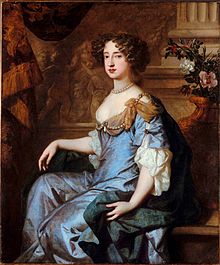
During the war with France, William tried to improve his position by marrying his first cousin Mary, elder surviving daughter of James, Duke of York, and eleven years his junior. Although he anticipated resistance to a Stuart match from the Amsterdam merchants who had disliked his mother (another Mary Stuart), William believed that marrying Mary would increase his chances of succeeding to Charles's kingdoms, and would draw England's monarch away from his pro-French policies. James was not inclined to consent, but Charles pressured his brother to go along. Charles wanted to use the possibility of marriage to gain leverage in negotiations relating to the war, but William insisted that the two issues be decided separately. Charles relented, and Bishop Henry Compton married the couple on 4 November 1677. Mary became pregnant soon after the marriage, but miscarried. After a further illness later in 1678, she never conceived again.
Throughout William and Mary's marriage, William had only one acknowledged mistress, Elizabeth Villiers, in contrast to the many mistresses his uncles openly kept.
Peace with France, intrigue with England
By 1678, Louis sought peace with the Dutch Republic. Even so, tensions remained: William remained very suspicious of Louis, thinking the French king desired "Universal Kingship" over Europe; Louis described William as "my mortal enemy" and saw him as an obnoxious warmonger. France's small annexations in Germany (the Réunion policy) and the revocation of the Edict of Nantes in 1685, caused a surge of Huguenot refugees to the Republic. This led William III to join various anti-French alliances, such as the Association League, and ultimately the League of Augsburg (an anti-French coalition that also included the Holy Roman Empire, Sweden, Spain and several German states) in 1686.
After his marriage in November 1677, William became a possible candidate for the English throne if his father-in-law (and uncle) James were excluded because of his Catholicism. During the crisis concerning the Exclusion Bill in 1680, Charles at first invited William to come to England to bolster the king's position against the exclusionists, then withdrew his invitation—after which Lord Sunderland also tried unsuccessfully to bring William over but now to put pressure on Charles. Nevertheless, William secretly induced the States-General to send the Insinuation to Charles, beseeching the king to prevent any Catholics from succeeding him, without explicitly naming James. After receiving indignant reactions from Charles and James, William denied any involvement.
In 1685, when James II succeeded Charles, William at first attempted a conciliatory approach, at the same time trying not to offend the Protestants in England. William, ever looking for ways to diminish the power of France, hoped James would join the League of Augsburg, but by 1687 it became clear that James would not join the anti-French alliance. Relations worsened between William and James thereafter. In November, James's wife Mary of Modena was announced to be pregnant. That month, to gain the favour of English Protestants, William wrote an open letter to the English people in which he disapproved of James's policy of religious toleration. Seeing him as a friend, and often having maintained secret contacts with him for years, many English politicians began to negotiate an armed invasion of England.
Glorious Revolution
Invasion of England
William at first opposed the prospect of invasion, but most historians now agree that he began to assemble an expeditionary force in April 1688, as it became increasingly clear that France would remain occupied by campaigns in Germany and Italy, and thus unable to mount an attack while William's troops would be occupied in Britain. Believing that the English people would not react well to a foreign invader, he demanded in a letter to Rear-Admiral Arthur Herbert that the most eminent English Protestants first invite him to invade. In June, James's wife, Mary of Modena, bore a son ( James Francis Edward Stuart), who displaced William's wife to become first in the line of succession. Public anger also increased because of the trial of seven bishops who had publicly opposed James's Declaration of Indulgence granting religious liberty to his subjects, a policy which appeared to threaten the establishment of the Anglican Church.
On 30 June 1688—the same day the bishops were acquitted—a group of political figures known afterward as the " Immortal Seven", sent William a formal invitation. William's intentions to invade were public knowledge by September 1688. With a Dutch army, William landed at Brixham in southwest England on 5 November 1688. He came ashore from the ship Brill, proclaiming "the liberties of England and the Protestant religion I will maintain". William had come ashore with approximately 11,000-foot and 4,000 horse soldiers. James's support began to dissolve almost immediately upon William's arrival; Protestant officers defected from the English army (the most notable of whom was Lord Churchill of Eyemouth, James's most able commander), and influential noblemen across the country declared their support for the invader.
James at first attempted to resist William, but saw that his efforts would prove futile. He sent representatives to negotiate with William, but secretly attempted to flee on 11 December. A group of fishermen caught him and brought him back to London. He successfully escaped to France in a second attempt on 23 December. William permitted James to leave the country, not wanting to make him a martyr for the Roman Catholic cause.
Proclaimed king
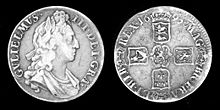
William summoned a Convention Parliament in England, which met on 22 January 1689, to discuss the appropriate course of action following James's flight. William felt insecure about his position; though his wife ranked higher in the line of succession to the throne, he wished to reign as King in his own right, rather than as a mere consort. The only precedent for a joint monarchy in England dated from the sixteenth century, when Queen Mary I married Philip of Spain. Philip remained king only during his wife's lifetime, and restrictions were placed on his power. William, on the other hand, demanded that he remain as king even after his wife's death. Although the majority of Tory Lords proposed to acclaim her as sole ruler, Mary, remaining loyal to her husband, refused.
The House of Commons, with a Whig majority, quickly resolved that the throne was vacant, and that it was safer if the ruler was Protestant. There were more Tories in the House of Lords which would not initially agree, but after William refused to be a regent or to agree to remaining king only in his wife's lifetime, there were negotiations between the two houses and the Lords agreed by a narrow majority that the throne was vacant. The Commons made William accept a Bill of Rights, and on 13 February 1689, Parliament passed the Declaration of Right, in which it deemed that James, by attempting to flee, had abdicated the government of the realm, thereby leaving the throne vacant. The Crown was not offered to James's eldest son, James Francis Edward (who would have been the heir apparent under normal circumstances), but to William and Mary as joint sovereigns. It was, however, provided that "the sole and full exercise of the regal power be only in and executed by the said Prince of Orange in the names of the said Prince and Princess during their joint lives".
William and Mary were crowned together at Westminster Abbey on 11 April 1689 by the Bishop of London, Henry Compton. Normally, the coronation is performed by the Archbishop of Canterbury, but the Archbishop at the time, William Sancroft, refused to recognise James's removal.
William also summoned a Convention of the Estates of Scotland which met on 14 March 1689, and sent a conciliatory letter while James sent haughty uncompromising orders, swaying a majority in favour of William. On 11 April, the day of the English coronation, the Convention finally declared that James was no longer King of Scotland. William and Mary were offered the Scottish Crown; they accepted on 11 May.
Revolution settlement
William III of England encouraged the passage of the Act of Toleration (1689), which guaranteed religious toleration to certain Protestant nonconformists. It did not, however, extend toleration as far as William wished, still restricting the religious liberty of Roman Catholics, non-trinitarians, and those of non-Christian faiths. In December 1689, one of the most important constitutional documents in English history, the Bill of Rights, was passed. The Act, which restated and confirmed many provisions of the earlier Declaration of Right, established restrictions on the royal prerogative. It provided, amongst other things, that the Sovereign could not suspend laws passed by Parliament, levy taxes without parliamentary consent, infringe the right to petition, raise a standing army during peacetime without parliamentary consent, deny the right to bear arms to Protestant subjects, unduly interfere with parliamentary elections, punish members of either House of Parliament for anything said during debates, require excessive bail or inflict cruel and unusual punishments. William was opposed to the imposition of such constraints, but he chose not to engage in a conflict with Parliament and agreed to abide by the statute.
The Bill of Rights also settled the question of succession to the Crown. After the death of either William or Mary, the other would continue to reign. Next in the line of succession was Mary II's sister, Princess Anne, and her issue. Finally, any children William might have had by a subsequent marriage were included in the line of succession. Roman Catholics, as well as those who married Catholics, were excluded.
Rule with Mary II
Resistance to validity of rule
Although most in Britain accepted William and Mary as sovereigns, a significant minority refused to accept the validity of their claim to the throne, holding that the divine right of kings was authority directly from God, not delegated to the monarch by Parliament. Over the next 57 years Jacobites pressed for restoration of James and his heirs. Nonjurors in England and Scotland, including over 400 clergy and several bishops of the Church of England and Scottish Episcopal Church as well as numerous laymen, refused to take oaths of allegiance to William.
Ireland was controlled by Roman Catholics loyal to James, and Franco-Irish Jacobites arrived from France with French forces in March 1689 to join the war in Ireland and contest Protestant resistance at the Siege of Derry. William sent his navy to the city in July, and his army landed in August. After progress stalled, William personally intervened to lead his armies to victory over James at the Battle of the Boyne on 1 July 1690, after which James II fled back to France.
Upon King William's return to England, his close friend Dutch General Godert de Ginkell, who had accompanied William to Ireland and had commanded a body of Dutch cavalry at the Battle of the Boyne, was named Commander in Chief of William's forces in Ireland and entrusted with further conduct of the war there. Ginkell took command in Ireland in the spring of 1691, and following several ensuing battles, succeeded in capturing both Galway and Limerick, thereby effectively suppressing the Jacobite forces in Ireland within a few more months. After difficult negotiations a capitulation was signed on 3 October 1691—the Treaty of Limerick. Thus concluded the Williamite pacification of Ireland, and for his services the Dutch general received the formal thanks of the House of Commons, and was awarded the title of Earl of Athlone by the King.
A series of Jacobite risings also took place in Scotland, where Viscount Dundee raised Highland forces and won a victory on 27 July 1689 at the Battle of Killiecrankie, but he died in the fight and a month later Scottish Cameronian forces subdued the rising at the Battle of Dunkeld. William offered Scottish clans that had taken part in the rising a pardon provided they signed allegiance by a deadline, and his government in Scotland punished a delay with the Massacre of Glencoe of 1692, which became infamous in Jacobite propaganda as William had countersigned the orders. Bowing to public opinion, William dismissed those responsible for the massacre, though they still remained in his favour; in the words of the historian John Dalberg-Acton, "one became a colonel, another a knight, a third a peer, and a fourth an earl."
William's reputation in Scotland was further damaged when he refused English assistance to the Darien scheme, a colony which then failed disastrously.
Parliament and faction
Although the Whigs were William's strongest supporters, he initially favoured a policy of balance between the Whigs and Tories. The Marquess of Halifax, a man known for his ability to chart a moderate political course, gained William's confidence early in his reign. The Whigs, a majority in Parliament, had expected to dominate the government, and were disappointed that William denied them this chance. This "balanced" approach to governance did not last beyond 1690, as the conflicting factions made it impossible for the government to pursue effective policy, and William called for new elections early that year.
After the Parliamentary elections of 1690, William began to favour the Tories, led by Danby and Nottingham. While the Tories favoured preserving the king's prerogatives, William found them unaccommodating when he asked Parliament to support his continuing war with France. As a result, William began to prefer the Whig faction known as the Junto. The Whig government was responsible for the creation of the Bank of England. William's decision to grant the Royal Charter in 1694 to the Bank, a private institution owned by bankers, is his most relevant economic legacy. It laid the financial foundation of the English take-over of the central role of the Dutch Republic and Bank of Amsterdam in global commerce in the 18th century.
William dissolved Parliament in 1695, and the new Parliament that assembled that year was led by the Whigs. There was a considerable surge in support for William following the exposure of a Jacobite plan to assassinate him in 1696. Parliament passed a bill of attainder against the ringleader, John Fenwick, and he was beheaded in 1697.
War in Europe
William continued to be absent from the realm for extended periods during his war with France, leaving each spring and returning to England each autumn. England joined the League of Augsburg, which then became known as the Grand Alliance. Whilst William was away fighting, his wife, Mary II, governed the realm, but acted on his advice. Each time he returned to England, Mary gave up her power to him without reservation, an arrangement that lasted for the rest of Mary's life.
After the Anglo-Dutch fleet defeated a French fleet at La Hogue in 1692, the allies for a short period controlled the seas, and Ireland was pacified thereafter by the Treaty of Limerick. At the same time, the Grand Alliance fared poorly in Europe, as William lost Namur in the Spanish Netherlands in 1692, and was badly beaten at the Battle of Landen in 1693.
Later years
Mary II died of smallpox on 28 December 1694, leaving William III to rule alone. William deeply mourned his wife's death. Despite his conversion to Anglicanism, William's popularity plummeted during his reign as a sole Sovereign.
Allegations of homosexual relations
During the 1690s rumours grew of William's alleged homosexual inclinations and led to the publication of many satirical pamphlets by his Jacobite detractors. He did have several close, male associates, including two Dutch courtiers to whom he granted English titles: Hans Willem Bentinck became Earl of Portland, and Arnold Joost van Keppel was created Earl of Albemarle. These relationships with male friends, and his apparent lack of more than one mistress, led William's enemies to suggest that he might prefer homosexual relationships. William's modern biographers, however, still disagree on the veracity of these allegations, with many contending that they were just figments of his enemies' imaginations, and others suggesting there may have been some truth to the rumours.
Bentinck's closeness to William did arouse jealousies in the Royal Court at the time, but most modern historians doubt that there was a homosexual element in their relationship. But William's young protege, Keppel, aroused more gossip and suspicion, being 20 years William's junior and strikingly handsome, and having risen from being a royal page to an earldom with some ease. Portland wrote to William in 1697 that "the kindness which your Majesty has for a young man, and the way in which you seem to authorise his liberties ... make the world say things I am ashamed to hear". This, he said, was "tarnishing a reputation which has never before been subject to such accusations". William tersely dismissed these suggestions, however, saying, "It seems to me very extraordinary that it should be impossible to have esteem and regard for a young man without it being criminal."
Peace with France
In 1696, the Dutch territory of Drenthe made William its Stadtholder. In the same year, Jacobites plotted to assassinate William III in an attempt to restore James to the English throne, but failed. In accordance with the Treaty of Rijswijk (20 September 1697), which ended the Nine Years' War, Louis recognised William III as King of England, and undertook to give no further assistance to James II. Thus deprived of French dynastic backing after 1697, Jacobites posed no further serious threats during William's reign.
As his life drew towards its conclusion, William, like many other European rulers, felt concern over the question of succession to the throne of Spain, which brought with it vast territories in Italy, the Low Countries and the New World. The King of Spain, Charles II, was an invalid with no prospect of having children; amongst his closest relatives were Louis XIV (the King of France) and Leopold I, Holy Roman Emperor. William sought to prevent the Spanish inheritance from going to either monarch, for he feared that such a calamity would upset the balance of power. William and Louis XIV agreed to the First Partition Treaty, which provided for the division of the Spanish Empire: Duke Joseph Ferdinand of Bavaria would obtain Spain, while France and the Holy Roman Emperor would divide the remaining territories between them. Charles II accepted the nomination of Joseph Ferdinand as his heir, and war appeared to be averted.
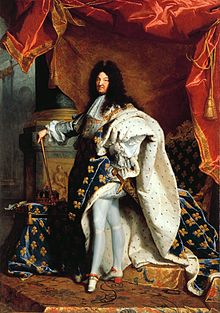
When, however, Joseph Ferdinand died of smallpox, the issue re-opened. In 1700, the two rulers agreed to the Second Partition Treaty (also called the Treaty of London), under which the territories in Italy would pass to a son of the King of France, and the other Spanish territories would be inherited by a son of the Holy Roman Emperor. This arrangement infuriated both the Spanish, who still sought to prevent the dissolution of their empire, and the Holy Roman Emperor, to whom the Italian territories were much more useful than the other lands. Unexpectedly, the invalid King of Spain, Charles II, interfered as he lay dying in late 1700. Unilaterally, he willed all Spanish territories to Philip, a grandson of Louis XIV. The French conveniently ignored the Second Partition Treaty and claimed the entire Spanish inheritance. Furthermore, Louis XIV alienated William III by recognising James Francis Edward Stuart, the son of the former King James II who had died in 1701, as King of England. The subsequent conflict, known as the War of the Spanish Succession, continued until 1713.
English succession
The Spanish inheritance was not the only one which concerned William. His marriage with Mary II had not yielded any children, and he did not seem likely to remarry. Mary's sister, the Princess Anne, had borne numerous children, all of whom died during childhood. The death of Prince William, Duke of Gloucester, in 1700 left the Princess Anne as the only individual left in the line of succession established by the Bill of Rights. As the complete exhaustion of the line of succession would have encouraged a restoration of James II's line, Parliament saw fit to pass the Act of Settlement 1701, in which it was provided that the Crown would be inherited by a distant relative, Sophia, Electress of Hanover, and her Protestant heirs if Princess Anne died without surviving issue, and if William III failed to have surviving issue by any subsequent marriage. (Several dozen Catholics with genealogically senior claims to Sophia were omitted.) The Act extended to England and Ireland, but not to Scotland, whose Estates had not been consulted before the selection of Sophia.
Death
In 1702, William died of pneumonia, a complication from a broken collarbone following a fall from his horse, Sorrel. Because his horse had stumbled into a mole's burrow, many Jacobites toasted "the little gentleman in the black velvet waistcoat." Years later, Sir Winston Churchill, in his A History of the English-Speaking Peoples, stated that the fall "opened the door to a troop of lurking foes". William was buried in Westminster Abbey alongside his wife. His sister-in-law Anne became queen regnant of England, Scotland and Ireland.
William's death brought an end to the Dutch House of Orange, members of which had served as stadtholder of Holland and the majority of the other provinces of the Dutch Republic since the time of William the Silent (William I). The five provinces of which William III was stadtholder—Holland, Zeeland, Utrecht, Gelderland and Overijssel—all suspended the office after his death. Thus, he was the last agnatic descendant of William I to be named stadtholder for the majority of the provinces. Under William III's will, John William Friso stood to inherit the Principality of Orange as well as several lordships in the Netherlands. He was William's distant agnatic relative, as well as son of William's aunt Albertine Agnes. However, King Frederick I of Prussia also claimed the Principality as the senior cognatic heir, his mother Louise Henriette being Albertine Agnes's older sister. Under the Treaty of Utrecht, which was agreed to in 1713, Frederick William I of Prussia (who kept the title as part of his titulary) ceded the Principality of Orange to the King of France, Louis XIV; Friso's son, William IV, shared the title of "Prince of Orange", which had accumulated high prestige in the Netherlands as well as in the entire Protestant world, with Frederick William after the Treaty of Partition (1732).
Legacy
William's primary achievement was to contain France when it was in a position to impose its will across much of Europe. His life was largely opposed to the will of Louis XIV of France. This effort continued after his death during the War of the Spanish Succession. Another important consequence of William's reign in England involved the ending of a bitter conflict between Crown and Parliament that had lasted since the accession of the first English monarch of the House of Stuart, James I, in 1603. The conflict over royal and parliamentary power had led to the English Civil War during the 1640s and the Glorious Revolution of 1688. During William's reign, however, the conflict was settled in Parliament's favour by the Bill of Rights 1689, the Triennial Act 1694 and the Act of Settlement 1701.
William endowed the College of William and Mary (in present day Williamsburg, Virginia) in 1693. Nassau, the capital of The Bahamas, is named after Fort Nassau, which was renamed in 1695 in his honour. Similarly Nassau County, New York a county on Long Island, is a namesake. Long Island itself was also known as Nassau during early Dutch rule. Though many alumni of Princeton University think that the town of Princeton, N.J. (and hence the university) were named in his honour, this is probably untrue. Nassau Hall, at the university campus, is so named, however.
The modern day Orange Order is named after William III, and makes a point of celebrating his victory at the Battle of the Boyne with annual parades by Orangemen all over Northern Ireland and parts of Scotland on 12 July. William or "Good King Billy" as he is sometimes known in Northern Ireland, has featured prominently in many loyalist murals. He is traditionally depicted mounted on his white horse.
New York City was briefly renamed New Orange for him in 1673 after the Dutch recaptured the city, which had been renamed New York by the British in 1665. His name was applied to the fort and administrative centre for the city on two separate occasions reflecting his different sovereign status—first as Fort Willem Hendrick in 1673, and then as Fort William in 1691 when the English evicted Colonists who had seized the fort and city.
Nassau Street (Manhattan), NY was also named some time before 1696 in his honour.
Titles, styles, and arms
| Royal styles of King William III of England |
|
|---|---|
 |
|
| Reference style | His Majesty |
| Spoken style | Your Majesty |
| Alternative style | Sire |
Titles and styles
- 4 November 1650 – 9 July 1672: His Highness The Prince of Orange, Count of Nassau
- 9–16 July 1672: His Highness The Prince of Orange, Stadholder of Holland
- 16 July 1672 – 26 April 1674: His Highness The Prince of Orange, Stadholder of Holland and Zeeland
- 26 April 1674 – 8 March 1702: His Highness The Prince of Orange, Stadholder of Holland, Zeeland, Utrecht, Gelre and Overijssel
- 13 February 1689 – 8 March 1702: His Majesty The King
By 1674, William was fully styled as "Willem III, by God's grace Prince of Orange, Count of Nassau etc., Stadholder of Holland, Zeeland, Utrecht etc., Captain- and Admiral-General of the United Netherlands". After their accession in Great Britain in 1689, William and Mary used the titles "King and Queen of England, Scotland, France and Ireland, Defenders of the Faith, etc."
Arms
The coat of arms used by the King and Queen was: Quarterly, I and IV Grandquarterly, Azure three fleurs-de-lis Or (for France) and Gules three lions passant guardant in pale Or ( for England); II Or a lion rampant within a double tressure flory-counter-flory Gules ( for Scotland); III Azure a harp Or stringed Argent ( for Ireland); overall an escutcheon Azure billetty and a lion rampant Or (for Nassau). In his later coat of arms, William used the motto: Je Maintiendrai (medieval French for "I will maintain"). The motto represents the House of Orange-Nassau, since it came into the family with the Principality of Orange.
Ancestry
Family tree
|
|
|
|
|
|
|
|
|
|
|
|
|
|
|
|
|
|
|
|
|
|
|
|
|
James I & VI 1566–1625 |
|
||||||||||||||||||||||||||||||||||||||||||||
|
|
|
|
|
|
|
|
|
|
|
|
|
|
|
|
|
|
|
|
|
|
|
|
|
|
|
|
|
|
|
|
|
|
|
|
|
|
|||||||||||||||||||||||||||||||||
|
|
|
|
|
|
|
|
|
|
|
||||||||||||||||||||||||||||||||||||||||||||||||||||||||||||
|
|
|
|
|
|
|
|
Frederick Henry 1584–1647 |
|
Amalia 1602–1675 |
|
|
|
|
|
|
|
Charles I 1600–1649 |
|
|
|
|
|
Elizabeth 1596–1662 |
||||||||||||||||||||||||||||||||||||||||||||||
|
|
|
|
|
|
|
|
|
||||||||||||||||||||||||||||||||||||||||||||||||||||||||||||||
|
|
|
|
|
|
|
|
|
|
|
|
|
|
|
|
|
|
|
|
|
|
|
|
|
|
|
|
|
|
|
|
|
|
|
|
|
|
|
||||||||||||||||||||||||||||||||
|
|
|
|
|
|
|
|
|
|
|
|
|
|
|
|
|
|
|
|
|
|
|
||||||||||||||||||||||||||||||||||||||||||||||||
| Frederick 1608–1708 |
|
Louise Henriette 1627–1667 |
|
Albertine Agnes 1634–1696 |
|
William 1626–1650 |
|
Mary 1631–1660 |
|
Charles II 1630–1685 |
|
James II & VII 1633–1701 |
|
Sophia 1630–1714 |
|||||||||||||||||||||||||||||||||||||||||||||||||||||||
|
|
|
||||||||||||||||||||||||||||||||||||||||||||||||||||||||||||||||||||
|
|
|
|
|
|
|
|
|
|
|
|
|
|
|
|
|
|
|
|
|
|
|
|
|
|
|
|
|
|
|
|
|
|
|
|
|
|
|
|
|
||||||||||||||||||||||||||||||
|
|
|
|
|
|
|
|
|
|
|
|
|||||||||||||||||||||||||||||||||||||||||||||||||||||||||||
|
|
|
|
|
Frederick 1657–1713 |
|
John William Friso 1687–1711 |
|
|
|
William III & II 1650–1702 |
|
|
|
Mary II 1662–1694 |
|
Anne 1665–1714 |
|
James 1688–1766 |
|
|
|||||||||||||||||||||||||||||||||||||||||||||||||
|
|
|
|
|||||||||||||||||||||||||||||||||||||||||||||||||||||||||||||||||||
|
|
|
|
|
|
|
|
|
|
|
|
|
|
|
|
|
|
|
|
|
||||||||||||||||||||||||||||||||||||||||||||||||||
Ahnentafel
| Ancestors of William III of England | ||||||||||||||||||||||||||||||||||||||||||||||||||||||||||||||||||||||||||||||||||||||||||||||||||||||||||||||||||||||||||||||||||||||||||||||||||||||||||||||||||||||||||||||||||||||||||||||||||||||||||||||||||||||||||||||||||||||||||||||||||||||||||||||||||||||||||||||||||||||||||||||||||||||||||||||||||||||||||||||||||||||||||||||||||||||||||||||||||||||||||||||||||||||||||||||||||||||||||||||||||||||||||||||||||||||||||||||||||||||||||||||||||||||||||||||||||||||||||||||||||||||||||||||||||||||||||||||||||||||||||||||||||||||||||||||||||
|---|---|---|---|---|---|---|---|---|---|---|---|---|---|---|---|---|---|---|---|---|---|---|---|---|---|---|---|---|---|---|---|---|---|---|---|---|---|---|---|---|---|---|---|---|---|---|---|---|---|---|---|---|---|---|---|---|---|---|---|---|---|---|---|---|---|---|---|---|---|---|---|---|---|---|---|---|---|---|---|---|---|---|---|---|---|---|---|---|---|---|---|---|---|---|---|---|---|---|---|---|---|---|---|---|---|---|---|---|---|---|---|---|---|---|---|---|---|---|---|---|---|---|---|---|---|---|---|---|---|---|---|---|---|---|---|---|---|---|---|---|---|---|---|---|---|---|---|---|---|---|---|---|---|---|---|---|---|---|---|---|---|---|---|---|---|---|---|---|---|---|---|---|---|---|---|---|---|---|---|---|---|---|---|---|---|---|---|---|---|---|---|---|---|---|---|---|---|---|---|---|---|---|---|---|---|---|---|---|---|---|---|---|---|---|---|---|---|---|---|---|---|---|---|---|---|---|---|---|---|---|---|---|---|---|---|---|---|---|---|---|---|---|---|---|---|---|---|---|---|---|---|---|---|---|---|---|---|---|---|---|---|---|---|---|---|---|---|---|---|---|---|---|---|---|---|---|---|---|---|---|---|---|---|---|---|---|---|---|---|---|---|---|---|---|---|---|---|---|---|---|---|---|---|---|---|---|---|---|---|---|---|---|---|---|---|---|---|---|---|---|---|---|---|---|---|---|---|---|---|---|---|---|---|---|---|---|---|---|---|---|---|---|---|---|---|---|---|---|---|---|---|---|---|---|---|---|---|---|---|---|---|---|---|---|---|---|---|---|---|---|---|---|---|---|---|---|---|---|---|---|---|---|---|---|---|---|---|---|---|---|---|---|---|---|---|---|---|---|---|---|---|---|---|---|---|---|---|---|---|---|---|---|---|---|---|---|---|---|---|---|---|---|---|---|---|---|---|---|---|---|---|---|---|---|---|---|---|---|---|---|---|---|---|---|---|---|---|---|---|---|---|---|---|---|---|---|---|---|---|---|---|---|---|---|---|---|---|---|---|---|---|---|---|---|---|---|---|---|---|---|---|---|---|---|---|---|---|---|---|---|---|---|---|---|---|---|---|---|---|---|---|---|---|---|---|---|---|---|---|---|---|---|---|---|---|---|---|---|---|---|---|---|---|---|---|---|---|---|---|---|---|---|---|---|---|---|---|---|---|---|---|---|---|---|---|---|
|
||||||||||||||||||||||||||||||||||||||||||||||||||||||||||||||||||||||||||||||||||||||||||||||||||||||||||||||||||||||||||||||||||||||||||||||||||||||||||||||||||||||||||||||||||||||||||||||||||||||||||||||||||||||||||||||||||||||||||||||||||||||||||||||||||||||||||||||||||||||||||||||||||||||||||||||||||||||||||||||||||||||||||||||||||||||||||||||||||||||||||||||||||||||||||||||||||||||||||||||||||||||||||||||||||||||||||||||||||||||||||||||||||||||||||||||||||||||||||||||||||||||||||||||||||||||||||||||||||||||||||||||||||||||||||||||||||
In popular culture
William has been played on screen by Bernard Lee in the 1937 film The Black Tulip, based on the novel by Alexandre Dumas, père, Henry Daniell in the 1945 film Captain Kidd, Olaf Hytten in the 1952 film Against All Flags, Alan Rowe in the 1969 BBC drama series The First Churchills, Laurence Olivier in the 1986 NBC TV mini-series Peter the Great, Thom Hoffman in the 1992 film Orlando, based on the novel by Virginia Woolf, Corin Redgrave in the 1995 film England, My England, the story of the composer Henry Purcell, Jochum ten Haaf in the 2003 BBC miniseries Charles II: The Power & the Passion, Bernard Hill in the 2005 film The League of Gentlemen's Apocalypse, and Russell Pate in the 2008 BBC film King Billy Above All.
